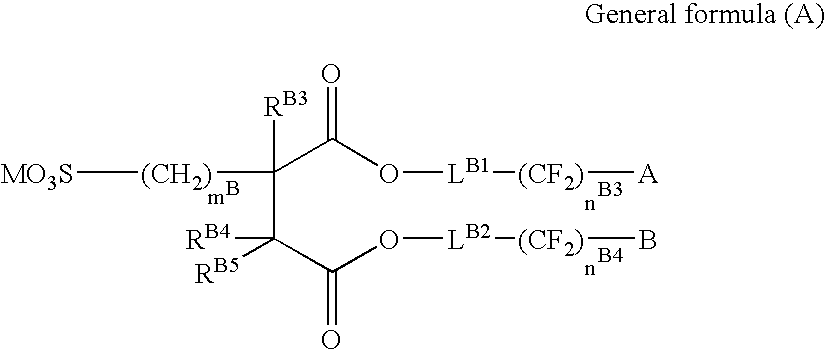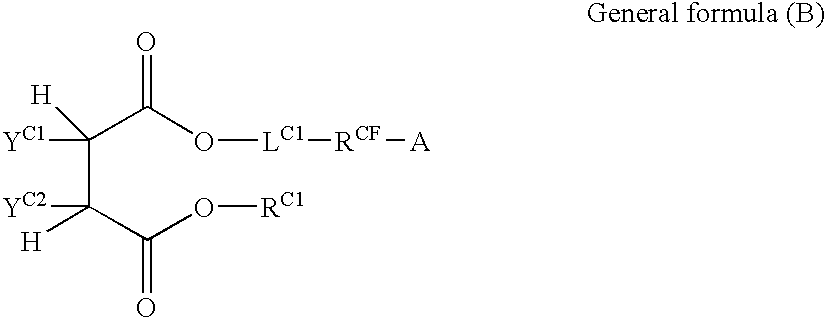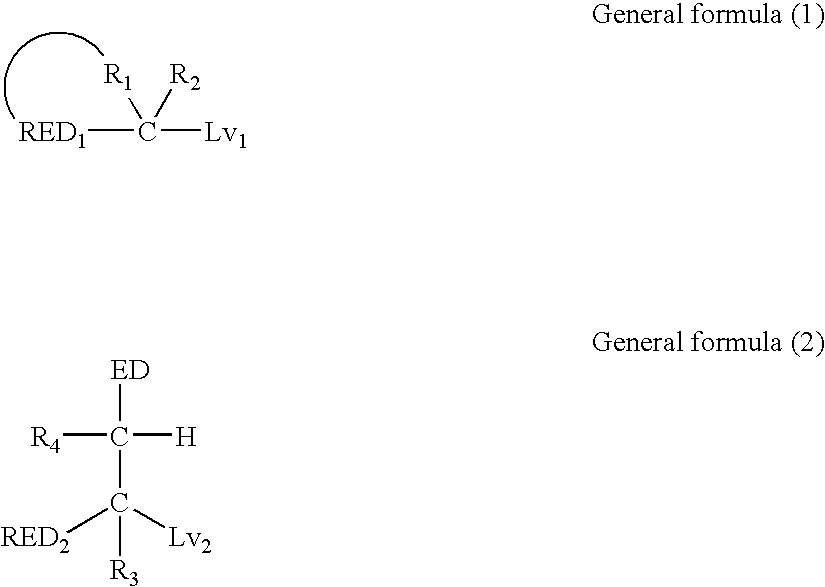Silver halide color photosensitive material
a color photosensitive material and silver halide technology, applied in the direction of photosensitive materials, auxiliaries/base layers of photosensitive materials, instruments, etc., can solve the problems of deterioration of photographic characteristics, increase of fog density, graininess deterioration, etc., to suppress static fog and high sensitivity
- Summary
- Abstract
- Description
- Claims
- Application Information
AI Technical Summary
Benefits of technology
Problems solved by technology
Method used
Image
Examples
synthetic example 1
Synthesis of Compound FS-201
1-1 Synthesis of di(3,3,4,4,5,5,6,6,6-nonafluorohexyl) Maleate
90.5 g (0.924 mol) of maleic anhydride, 500 g (1.89 mol) of 3,3,4,4,5,5,6,6,6-nonafluorohexanol and 17.5 g (0.09 mol) of p-toluenesulfonic acid monohydrate were heated in 1000 L of toluene under reflux while distilling off formed water for 20 hr. The thus obtained reaction mixture was cooled to room temperature, and toluene was added thereto. The organic phase was washed with water, and the solvent was distilled off in vacuum, thereby obtaining 484 g of desired product (yield 86%) as a transparent liquid.
1-2 Synthesis of Compound FS-201
514 g (0.845 mol) of di(3,3,4,4,5,5,6,6,6-nonafluorohexyl) maleate, 91.0 g (0.875 mol) of sodium hydrogen sulfite and 250 mL of water / ethanol (1 / 1 v / v) were mixed together, and heated under reflux for 6 hr. 500 mL of ethyl acetate and 120 mL of a saturated aqueous solution of sodium chloride were added to the mixture, and an extraction was effected. The org...
synthetic example 2
Synthesis of Compound FS-303
2-1 Synthesis of 2-ethylhexyl Maleate Chloride
4.5 g (20 mmol) of mono(2-ethylhexyl) maleate, product of Aldrich, was slowly dropped in 4.1 g (20 mmol) of phosphorus pentachloride while maintaining the temperature of the mixture at 30° C. or below. After the completion of dropping, the mixture was agitated at room temperature for 1 hr. Thereafter, the mixture was heated to 60° C., and the pressure was reduced by an aspirator to thereby distill off formed phosphorus oxychloride. As a result, there was obtained 4.5 g (yield: 92%) of light brown oily compound consisting of 2-ethylhexyl maleate chloride.
2-2 Synthesis of mono(2-ethylhexyl) mono(2,2,3,3,4,4,4-heptafluorobutyl) Maleate
66.8 g (0.334 mol) of 2,2,3,3,4,4,4-heptafluorobutanol and 29.6 mL (0.367 mol) of pyridine were dissolved in 180 mL of acetonitrile, and while maintaining the internal temperature at 20° C. or below by cooling with an ice bath, 90.6 g (0.367 mol) of mono(2-ethylhexyl) maleate ...
synthetic example 3
Synthesis of Compound FS-312
3-1 Synthesis of Monodecyl mono(3,3,4,4,5,5,6,6,6-nonafluorohexyl) Maleate
164.6 g (623 mmol) of 3,3,4,4,5,5,6,6,6-nonafluorohexanol and 49.3 mL (623 mmol) of pyridine were dissolved in 280 mL of chloroform, and while maintaining the internal temperature at 20° C. or below by cooling with an ice bath, 155.8 g (566 mmol) of monodecyl maleate chloride was dropped in the solution. After the completion of dropping, the mixture was agitated at room temperature for 1 hr. Thereafter, ethyl acetate was added, and the organic phase was washed with a 1 mol / L aqueous hydrochloric acid solution and a saturated aqueous sodium chloride solution. The resultant organic layer was collected, and the organic solvent was distilled off in vacuum. Purification by silica gel column chromatography (hexane / chloroform: 10 / 0 to 7 / 3 v / v) was performed, thereby obtaining 48.2 g (yield: 18%) of desired compound.
3-2 Synthesis of Sodium Monodecyl mono(3,3,4,4,5,5,6,6,6-nonafluorohexy...
PUM
 Login to View More
Login to View More Abstract
Description
Claims
Application Information
 Login to View More
Login to View More - R&D
- Intellectual Property
- Life Sciences
- Materials
- Tech Scout
- Unparalleled Data Quality
- Higher Quality Content
- 60% Fewer Hallucinations
Browse by: Latest US Patents, China's latest patents, Technical Efficacy Thesaurus, Application Domain, Technology Topic, Popular Technical Reports.
© 2025 PatSnap. All rights reserved.Legal|Privacy policy|Modern Slavery Act Transparency Statement|Sitemap|About US| Contact US: help@patsnap.com



